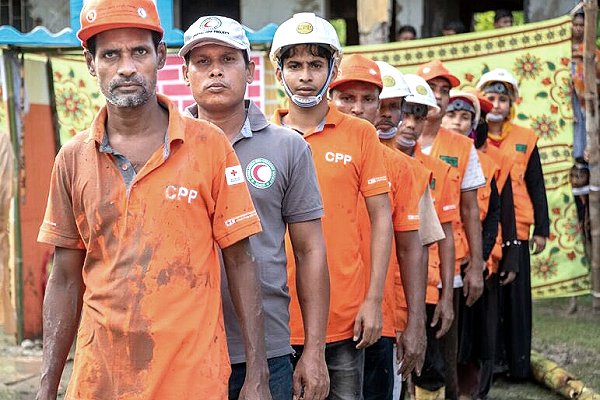
‘Virus-hit Asian nations brace for double disasters as extreme weather looms’

(This story appeared first on Thursday on the website of the Thomson Reuters Foundation. It has been edited slightly here for time references.)
As the season of monsoons, heatwaves and cyclones hits, many Asian and Pacific island nations fear being stretched too thin.
Countries from India to the Philippines, already struggling with the coronavirus pandemic, are likely to also battle weather-related crises, from heatwaves to cyclones, in coming months, disaster experts warned.
In India – currently under lockdown with more than 12,000 confirmed cases of the virus – the cyclone season starts in less than two weeks, said Kamal Kishore, a member of the country’s National Disaster Management Authority.
To try to maintain social-distancing requirements, India would need to double the space available to shelter people from extreme weather, he said in a webinar organized by the United Nations Office for Disaster Risk Reduction.
That means schools and colleges currently closed by the virus outbreak, as well as other buildings, may need to be turned into shelter sites, he said.
Cyclone Harold
May and June are also the hottest months for India and Pakistan. People without adequate access to cooling or sufficient water could face health risks, particularly during the lockdown, scientists warned.
An intense heatwave last May and June caused widespread deaths across India.
With hospitals already filling with COVID-19 patients, “we really have to work doubly hard this year to make sure that we minimise the heatwave-related burden on hospitals,” said Kishore.
Meanwhile in Vanuatu, around 160,000 people are in need of assistance after Cyclone Harold tore through South Pacific islands, said Sanaka Samarasinha, UN resident coordinator in Fiji.
“Crops have been all but destroyed,” he said. If a new season of crops isn’t quickly planted, “we will be looking at food insecurity for quite some time,” he warned.
The disaster forced the government to announce a second state of emergency on 11 April, after an earlier one banned mass gatherings as a result of coronavirus fears.
Vanuatu has said it has no confirmed cases of the virus as of 15 April.
Pacific storms
Islands in the North Pacific, meanwhile, may have to contend with drought-like conditions as well as the virus, said Lemau Afamasaga from the Palau Red Cross Society.
“In the past couple of months, part of the work is encouraging the local communities to wash their hands but…we were asked, ‘How do we wash our hands when there is a lack of water?’,” she said.
The Philippines, meanwhile, is juggling more than 5,600 COVID-19 cases – the highest number in South-East Asia – as well as thousands of people displaced by a volcano eruption in January and by last year’s cyclones.
Elizabeth Zavalla, secretary-general of the Philippine Red Cross, said the association is manning a 24-hour call centre on the coronavirus as well as distributing aid to disaster victims.
The Philippine monsoon season starts in May but most of the more than 20 storms the country sees each year come between June and August, she said.
As Asian and Pacific countries brace to handle extreme weather and virus outbreaks at the same time, it is crucial disaster response teams are provided with personal protective equipment and psychological support, experts said.
“COVID-19 is a crisis which is not going to dissipate in two or three weeks,” warned India’s Kishore.
“It will take months and those months will also coincide with floods and cyclones and heat waves – so the demand on response forces will be huge.”
*
Climate Centre Director Maarten van Aalst writes: It won’t have come as a surprise that in the same webinar that the Thomson Reuters Foundation have given us an account of here, we should meet Ahmadul Haque, director of Bangladesh’s world-famous Cyclone Preparedness Programme, outlining the CPP view of the issues behind planning for the twin challenges of COVID-19 and the cyclone season.
Shoulder to shoulder with the Bangladesh Red Crescent Society (photo) they will be able to evolve their strategy using what Achala Navaratne, country rep for the American Red Cross, called “decades of experience, practice and learning”.
Navaratne says they are jointly “developing new guidance for community volunteers on managing early warning, early action and evacuations in a time of COVID-19”.
It will not be easy, and it poses dilemmas that have already been faced for real in Vanuatu and other Pacific island nations with Tropical Cyclone Harold.
One issue already discussed in Bangladesh and touched on in the webinar is the difficulty of maintaining social distancing in shelters, should the need arise to move people into them.
‘Decades of experience,
practice and learning’
The cost and supply of personal protective equipment – equally an issue even in the rich global North – is another.
With Bangladesh in lockdown and many people out of work, like much of the rest of the world, the BDRCS has already been “working round the clock and trying to reach people with…food parcels,” the IFRC’s Raqibul Alam tells us.
But these are relatively early days in terms of a refined dual-hazard strategy.
Ahmadul Haque highlighted, for example, the need to redesign early warning, redefine evacuation and shelter procedures, change healthcare and first aid protocols, and generally adapt humanitarian assistance.
In short, we have to move from simply climate-smart early warning early action to a response that is “smart” twice over; if anyone can show how that can be done it’s surely Bangladesh.
Bangladesh’s Red Crescent and Cyclone Preparedness Programme personnel are ready together to try to meet the twin challenges of the cyclone season and COVID-19. (Photo: @AchalaNavaratne)